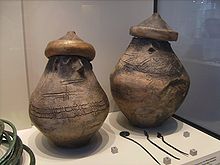Pomeranian face urn culture

The Pomeranian face urn culture , also called Pomoran culture (Polish: kultura pomorska or kultura wschodniopomorska ) and Pomeranian culture , was an Iron Age culture in today's Poland .
The center of the Pomeranian face urn culture was between the Lower Vistula and Gdańsk Bay in the east and the Stolpe (Polish: Słupia ) in the west. It developed in the 7th century BC. From the Kashubian group of the Lausitz culture . Characteristic were urns with facial representations , which were buried in stone boxes. Typical grave goods were bronze fibulae and rings. The burial customs are strikingly similar to those of the simultaneous house urn culture between the Harz and the mouth of the Saale .
The economy was similar to that of the Lausitz culture. Rye was first systematically cultivated, but only made up a small part of the grain. Wall castles on hills were rarer than further west in the Lusatian culture.
In the further course of the Iron Age, the culture expanded further. The bell burial culture developed through mixing with other cultures .
There is a presumption that the bearers of the facial urn culture were the Bastarnen . These were only mentioned by ancient authors such as Tacitus when they appeared in the lower Danube region and settled there.
literature
- Rosemarie Müller: Face urn culture. In: Reallexikon der Germanischen Altertumskunde (RGA). 2nd Edition. Volume 11, Walter de Gruyter, Berlin / New York 1998, ISBN 3-11-015832-9 , pp. 543-547.
- Hallstatt period . In: Ingrid Griesa, Rainer-Maria Weiss, Wilfried Menghin (eds.): The antiquities in the museum for prehistory and early history . Volume 2, Berlin 1999, ISBN 3-8053-2566-5 .
